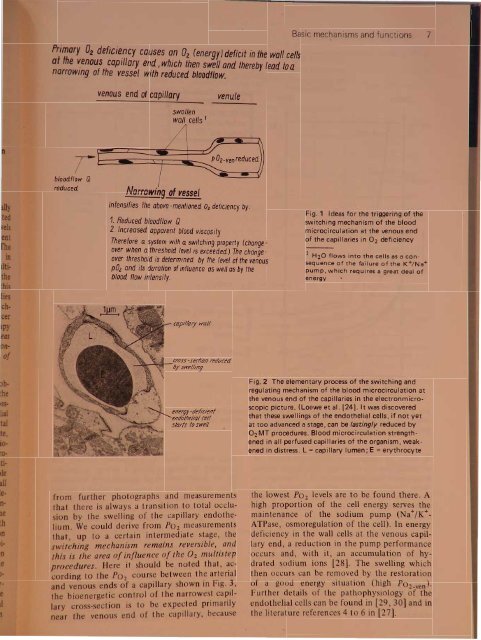Chapter-1 / Physiological Foundations - WHNLive Public Library
Chapter-1 / Physiological Foundations - WHNLive Public Library
Chapter-1 / Physiological Foundations - WHNLive Public Library
Create successful ePaper yourself
Turn your PDF publications into a flip-book with our unique Google optimized e-Paper software.
'7%ary O2 deficie.ncy causes on O 2 (energyJdeficit in the wall cellsa e ~enaus capillary end, which then swell and thereby lead toanarrowmg of the vessel with reduced bloodflow.Basic mechanisms and functions 7venous end 01 capillaryswollenwall cells'venulebloodflow Qreduced.Narrowing of vesselintensifies the above -mentioned Oz deficiency by:1. Reduced bloodflow Q2. Increased apparent blood viscosityTherefore a system with a sWitching property (changeoverwhen a th~eshold level is exceeded). The changeoverthreshold IS determined by the level of the venouspOz and its duration of influence as well as by theblood flow intensity.Fig. 1 Ideas for the triggering of theswitching mechanism of the bloodmicrocirculation at the venous endof the capillaries in 02 deficiency1 H20 flows into the cells as a consequenceof the failure of the K+/Na+pump, which requires a great deal ofenergy •alplliory wallcross -sedlon rt'tI(/c~d';.o.;.;:....-Wt--byswt>llingenergy-tieficiMtt'lJt!olhl'llol cellstarts to swellFig. 2 The elementary process of the switching andregulating mechanism of the blood microcirculation atthe venous end of the capillaries in the electronmicroscopicpicture. (Loewe et al. [24]. It was discoveredthat these swellings of the endothelial cells, if not yetat too advanced a stage, can be lastingly reduced byO 2 MT procedures. Blood microcirculation strengthenedin all perfused capillaries of the organism, weakenedin distress. L =capillary lumen; E =erythrocytefrom further photographs and measurementsthat there is always a transition to total occlusionby the swelling of the capillary endothelium.We could derive from P02 measurementsthat, up to a certain intermediate stage, theswitching mechanism remains reversible, andthis is the area ofinfluence ofthe 02 multistepprocedures. Here it should be noted that, accordingto the P0 2course between the arterialand venous ends of a capillary shown in Fig. 3,the bioenergetic control of the narrowest capillaryero. s- ection is to be expected primarilynear the venous end of the capillary, becau ethe lowest P0 2levels are to be found there. Ahigh proportion of the cell energy serves themaintenance of the sodium pump (Na+/K+ATPase, osmoregulation of the cell). In energydeficiency in the wall cells at the venou capillaryend, a reduction in the pump performanceoccurs and, with it, an accumulation of hydratedsodium ions [28]. The welling whi hthen occurs can be removed by the re torationof a good energy ituation (high P0 2_ n)'Further detail of th pathophy iology f thendothelial cells can be found in [29 30] and inthe literature reference 4 to 6 in [27].













